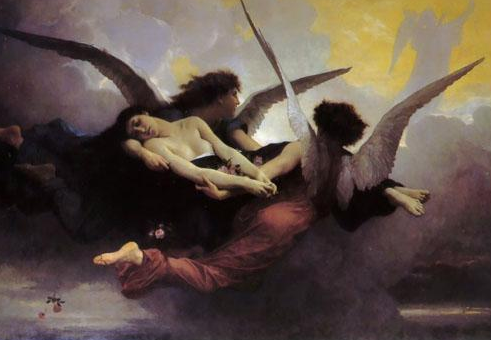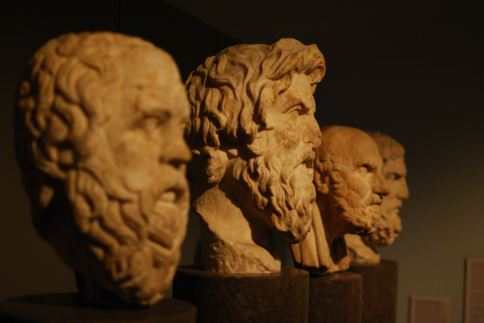The doctrine of reincarnation, accepted by some ancient religions, is denied by most of the great modern religions, except in some eastern areas, mainly because of the influence of Christianity, which states that it is philosophically unacceptable: the human souls are unique, each united substantially, to its “body” and of an immortal nature; the transmigration of souls is contrary to this experience and ethically contradictory according to today religions.

In some primitive peoples it is not clearly found the notion of a homogeneous, single, spiritual soul in the body; ethnology shows they rather considered as different “souls” various forces which are in the human body (Animism); although other peoples did reach the reality of individualized soul. In any case, rather than the reality of the individual soul, this spiritual entity, which is more clearly recognized by superior cultures, many cultures often embraced the concept, at least, of a substance of life, of power, the mana, multifaceted, collective and temporarily personified in humans. Upon death, a portion of this substance would go back to its undifferentiated, original state; another would remain for a short period of time wandering around the living, and another part would incarnate again in a newborn. Studies in Melanesia, in Africa, show a general belief in continued life of the ancestors in newborns in tribes, being this life a set of powers, psychic forces whose part is embodied in the new human being. Therefore, in the primitive, in general, we can not speak of a transmigration of souls itself.
Transmigration of souls understood by various peoples and religions
Egypt
The Orphic
The Orphic were followers of a mystery religion, ie, which was accessed by initiation, based on poems attributed to Orpheus. These writings were related to the origin and destiny of the soul. Those letters were written over a long period of time by various poets, artists and followers related to this religious movement.
The Orphic never built a stable church or had a hierarchy to watch over dogmas of any kind. Therefore, the doctrines attributed to Orpheus had various philosophical interpretations. However, there were a number of principles that remained very stable throughout its history. One of them is the idea of the transmigration of souls.
The most objective and particular reference is a compilation of fragments called Rhapsodies, a poem in hexameter attributed to Orpheus and dated to the first century BC.
Summary of the transmigration of souls in the Rhapsodies:

- There is transmigration of souls in humans and animals.
- The soul is immortal.
- There are different treatments of the animals with respect to humans. This is the base of the vegetarianism practiced by the Orphic.
- Souls are taken for purification and punishment.
- Souls are treated differently in the the other world, where justice and purity are two fundamental aspects to salvation.
- Three centuries is the period which bears the soul in the afterlife until its genesis (Plato stated a thousand years) or complete period of purification of human souls, according to the way they have lived during their transit through the genesis. Although this period does not indicate the actual duration of the process; it is a symbolic number.
- The soul is based on the myth of the Titans, conceived as a punishment.
- The animal soul at death remains in the air and transmigrates into another being, along with the air.
- The human soul is carried by Hermes to the Elysium or to the Tartarus.
- The release of the soul depends on Dionysus and Persephone.
- To access the Elysees: initiation rituals, justice, purification.
- Orpheus is the mediator in this process.
- The idea that the soul is inspired with the air is well documented by Aristotle.
In sum, the transmigration of the soul appears as a punishment (myth of the Titans). On the one hand, human beings come from gods (the Titans and Dionysus) with an immortal, divine part; on the other hand, from Earth, with their mortal and corruptible body. But their souls, before the actual origin of the species, had been polluted by the crime of the Titans, a crime that leaves a mark in human nature: a part of the “titanic nature,” that is, of the pride of his predecessors, and it should be expiated. The soul must be freed of the weight of the criminal part. Consequently, the input of the soul in a body, atonement and liberation to its death are repeated several times in a very long process, in which the soul is hosted successively in bodies that work as a grave. Therefore, transmigration of souls is for the Orphic the reincarnation from the other world to this one and from one body to another, until the guilt is expiated, so in Hades and in this world, it can guarantee its release.
The Orphic say that the soul is divine, immortal and possesses the following faculties: memory, intelligence, will. Moreover, it is only truly alive when the body dies and gets rid of it. In short, the soul is dead as it is in the body, as its real life takes place in Hades and therefore we can say that the body is like a sepulture for it.
Greece

Among the Greeks and Homer’s time, the idea of the post mortem existence was also confusing; the description of the evocation of Tiresias proves it. The Greeks always felt horror and fear of death, and did not conducted a search to discover the states after it. It was Pindar, the Dorian poet of Thebes, who in his second Olympic affirmed his belief in the transmigration of souls, but Empedocles seems to be the first pre-Socratic philosopher who confirmed the transmigration of souls under the influence of Orphism. Indeed, in Greece and along with the state religion of the Greek polis, we should note the existence of a powerful philosophical and gnostic current, explained by Orphism, the Pythagoreans and authors who described a theogony and mysticism very different from the traditions. Orphism and the Orphic mysteries recognized the need to return to Earth for the subsequent purification of human souls; the opposition was total by this Orphic concept of life, with its asceticism and its initiations, entirely oriented towards the past, and the Homeric religion with its heroic optimism and love of life. Plato continued these speculations of mystical type of the sixth Greek century and it has been said that his thinking was a Pythagorean interpretation of the teachings of Socrates. Pythagoras, creator of a religion, an extraordinary figure of the Mediterranean world in the fifth century approved the transmigration of souls according to what his disciples tell about him. Teaching and influence of Aristarchus of Samos were strong enough to influence all philosophical Greeks, especially the later Platonists systems. The similarity of cyclical concepts of Pythagoras with the Orphic is clear: the fallen soul is purified by successive steps on the scales of life to eventually return to God, its Creator.
Plato also knew the Orphic teaching; he believed in the “burial” of the soul in the body, the necessary purification (katharsis) and the mystical contemplation. In the form of great myths, this philosopher was the first Greek to affirm the concept of individual immortality; He admitted the fall of the soul, the total duality between soul and matter, which belong to two different worlds; the soul is chained to the body (Timaeus); but Plato explains his theory of reminiscence including former existences of the soul. The Phaedrus (248 BC.) explains how the soul acquired before its current incarnation knowledge of the realities whose memory will be the present life. This theory is of great importance around Plato, because, for him, learning is remembering; The Phaedo and also the Republic expose their theories about transmigration of souls using the great myth of Er The Pamphylian son of Armenians, who having passed the gates of death, comes back with permission of the gods. G. Rodier said that Plato drew his theory of transmigration of souls based on the Orphic and Pythagorean mysteries. But the philosophical basis of the system is, as we have seen, the theory of reminiscence, his belief in the ascent of the soul through the body to the divine happiness.
Read also: Reincarnation Proof: 6 Real Evidences of Reincarnation
Rome

In Rome, the concept of the transmigration of souls It was admitted only as a reflection of the Orphic-Pythagorean doctrines that played an important role in the imperial capital, as demonstrated by J. Carcopino; Virgilio knew the doctrine of the transmigration of souls and he believed in it, according to the Aeneid, and Ovid in his Metamorphoses refers to these beliefs and relies on them to ask for animals not to be killed and thus not injure souls relatives of men.
Gnosticism and hermetic theories of Alexandria understood the transmigration of souls, as seen in the Pistis Sophia. This concept was the key to salvation and redemption of the Gnostics. According to Biruni, Manichaeism also taught this doctrine, which appears in Manichaean texts such as the Acta Archelai. The Alexandrian school taught transmigration of souls; Plotinus acknowledged that the human soul, an emanation of the universal soul, precedes the creation of the body, which is only an instrument for it. In his Enneads he taught the reincarnation and the possibility that the souls of the animals could be fallen human souls.
Transmigration of souls in the Eastern World

In Asia, the transmigration of souls is a doctrine generally accepted in all cultures with different nuances. In India, Hinduism and Brahmanism made the transmigration of souls a fundamental doctrine whose origin is the theory of action, Karma, the law of causality carried ethically. Souls travel from body to body and suffer the result of their actions, their karma, which thus becomes a law of immanent justice, acting with an almost mechanical efficiency. The philosophical school of Vedanta, currently the most important in India, supports transmigration of souls, but is far from the Greek thought.; transmigration is not a purification that gradually leads the soul to the contemplation of Truth, as Plato believed, but the transmigrating souls follow the results of their past actions, their karma. This physical-psychic act has a moral meaning, an ethical value and the law of karma is a metaphysical concept in which every action carries its reward or punishment, as the seed of the fruit. Some Hindu schools of devotion to the Lord added that Almighty God has power over the law of karma and His will also plays a part in the cosmic game of this law.
Read also: Do Hindus Believe In Reincarnation?
Buddhism and Jainism, heterodox systems in India, accept the law of karma and the transmigration of souls as the origin of pain and the wheel of the world (samsara), in which there are chained six species of beings. The suppression of the primary ignorance liberates the individual who realizes the causes of the human condition through meditations and yoga techniques taught by Buddha and Mahavira. In China, despite the doctrine of Confucius does not care much about what happens after death, as it is first of all a school of social behavior and political wisdom, Taoism conceives transmigration of souls, although the special concept that it had around the perpetual cycle of nature makes it better to speak of a doctrine of transmutation. It is not a matter of big importance for taoists the individual becoming, since the human being is composed of several “souls”, natural forces that closely resemble the concept of psychic forces of the primitive. In Japan, the Shinto lacked the concept of reincarnation, and it was Buddhism that then introduced it as it did in China. As is known, the Japanese Buddhism mirrored the Chinese Buddhism and its philosophical positions of salvation; the starting point is the law of transmigration with painful consequences, which was not discussed because it belongs to the roots of the Buddhist doctrine itself. The various Japanese Buddhist schools taught several methods of liberation ranging from simple pronunciation of the holy name of Buddha to yoga techniques of the Hosso sect and tantric magic of the Shingon sect.
Read also: Do Buddhists Believe In Reincarnation?
Modern trends

With the Christian revelation that confirms and clarifies the existence and nature of the human soul and the subject of immortality, belief in the transmigration of souls disappeared along with many pagan religions, and is no longer found, in general, among the speculations and theories of thinkers. However, the influence of Platonism in the various Western schools of Renaissance curiously coincides with the belief in the transmigration of souls of those schools; Hellenism never disappeared completely from Western thought. The conquest of Constantinople by the Arabs produced the migration of Greek scholars to Italy, which became a new Greece; Italian humanists followed Plato, Aristotle, Pythagoras and Plotinus. Plato enlightened the scene of the Renaissance philosophers; Cardinal Nicholas of Cusa (1401-1464) knew Neoplatonism Pythagorean theory and arithmetic. Cosimo de Medici in 1460 established a Platonic Academy in Florence and Marsilio Ficino (1433-1499) sought the agreement between the Platonic doctrines and the Christian dogma, talking about a common religion to all mankind, and accepted the theory of reincarnation.
Read also: Do Christians Believe In Reincarnation?
Later also the University of Cambridge received a strong Platonic influence with the names of Ralph Cudworth (1617-1685), Henry More (1614-1687), Benjamin Wichcote (1609-1683) and John Smith (1616-1652). The “Cambridge Platonists’ opposed to the theories of Hobbes and built a new neo-Platonic metaphysics theory, including transmigration of souls. The University of Padua, with Jerome Cardan (1501-1576) and thinkers such as Giordano Bruno (1548-1600) and the Dominican Campanella (1568-1639), accepted the theory of the transmigration of souls in all its philosophical and social systems.
Western classical philosophers, with the English empiricism, the criticism of Kant and Hegel’s idealistic objectivism were at the opposite pole of Plato, so the hypothesis of reincarnation disappeared from their theories. Some thinkers of the nineteenth century with philosophical and social concerns followed Pythagorean and Platonic doctrines: Ballanche (1776-1847), Charles Fourier (1772-1837), Pierre Leroux (1798-1871) and read Reynaud (1806-1863) admitted the transmigration of souls in their theories.
We know that spiritualism and theosophy renewed the ancient pagan beliefs; but they prefer to use the term reincarnation over transmigration of souls to indicate that they limit the incarnation of souls only to human bodies.
Catholic doctrine, Judaism and Islam do not accept the transmigration of souls, nor does the Old Testament. Even though some authors have discussed the belief in reincarnation of certain Jewish sages, it should not be confused with the pre-existence of human souls that Palestinian doctors seem to admit, considering that Yahweh had created all souls together once; some rabbis admit that souls in seventh heaven await the opportunity to incarnate. The sect of the Pharisees, opposed to the Sadducees, came to accept many Greek ideas along with the Hebrew religion; according to Flavius Josephus, they accepted even Orphic and Pythagorean ideas about the transmigration of souls, perhaps through them these ideas, some centuries after Christ, they came to accept the Kabbalah, a kind of Jewish gnosis, which accepts reincarnation, as shown in the text of Zolhar.
Read also: Do Jews believe In An Afterlife?
The transmigration of souls is not compatible with the revelation of the Old Testament nor the New Testament. Christianity never accepted the transmigration of souls. In some Father of the Church texts and ancient writings there are certain expressions that might favor the belief in the pre-existence of souls, as St. Justin, heavily influenced by Plato. The early Christians did not deal very directly with this issue, or the transmigration of souls. itself, as the Christian revelation is clear about the value and personal responsibility of every soul and its eternal destiny. But Athenagoras and St. Irenaeus in the second century fought directly against reincarnation, that the Gnosis taught back then, as other Fathers later did.
It was Origen who brought a condemnation of the transmigration of souls although he never taught this theory, but the pre-existence of souls, the primitive equalness of all souls and universal restoration in Christ. It was his disciples who created Origenism in their fight against the doctors of the Eastern Church. The Council Of Constantinople (year 553) condemned the doctrines of Origenism. Since then, the Magisterium has not addressed the issue directly, although the doctrine of the transmigration of souls, Indirectly, is clearly excluded for opposing certain fundamental truths of Revelation
“The souls of those who are saved are welcomed immediately in heaven”. Council of Lyon, 1274.
“The souls of those who are condemned immediately go down to hell to suffer the punishment they deserve”. Council of Florence, 1439.
In recent times the Sacred Congregation of the Holy Office stated that the theosophical doctrines are not reconcilable with the Catholic doctrine (year 1919).
The opposition between Catholic doctrine and the transmigration of souls is evident since this theory is completely incompatible with Catholic thesis about the soul. In addition, the resurrection of the bodies totally contradicts the transmigration of souls and the doctrine of eternal punishment in hell.
It can be added as an argument against reincarnation, the total loss of memory, which we should have of our past lives, this also destroys its ethical effectiveness. The ancients imagined that the Lethe river waters made souls forget their past lives. Without this memory, one can not speak of punishment or reward, since for the guilty to be recognized as such, he should have the memory of his faults. How can there be punishment without memory of the fault?
Video:Transmigration of Souls and Reincarnation – 2 mins
This concludes our article about transmigration of souls. Share with your contacts to spread the knowledge. Keep reading this website to learn more about reincarnation and the afterlife.






